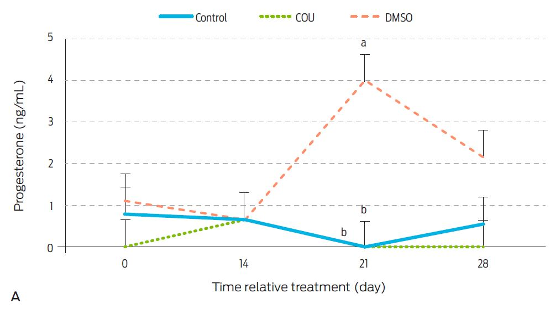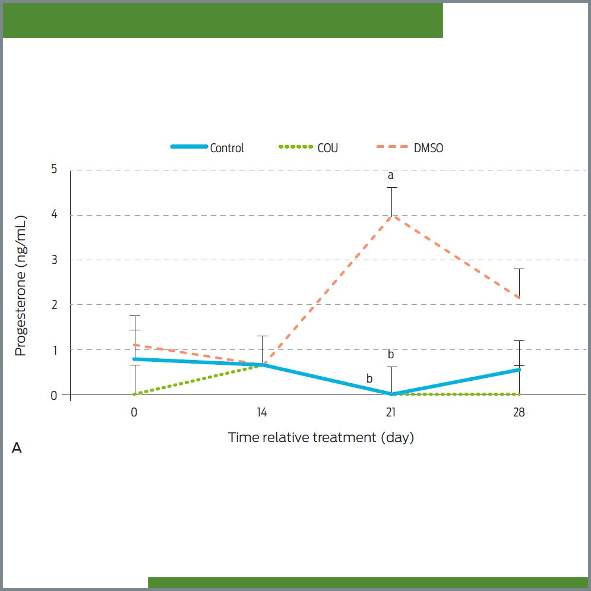Effect of a single application of coumestrol and/or dimethyl sulfoxide, on sex hormone levels and vaginal cytology of anestrus bitches
Main Article Content
Abstract
Veterinaria México OA
ISSN: 2448-6760
Cite this as:
- Peña-Corona S, León P, Mendieta E, Villanueva M, Salame A, Vargas D, Mora G, Serrano H, Villa-Godoy A. Effect of a single application of coumestrol and/or dimethyl sulfoxide, on sex hormone levels and vaginal cytology of anestrus bitches. Veterinaria México OA. 2019;6(1) doi: 10.22201/fmvz.24486760e.2019.1.656.
Canine overpopulation continues to be a problem with serious public health implications, despite a diversity of programs and strategies that have been implemented for its control. Coumestrol (COU) is an organic compound with estrogenic activity, thus having the potential to alter reproduction in mammals. COU is commonly dissolved in dimethyl sulfoxide (DMSO) before administration; however, evidence indicates that DMSO is not inert. The aim of this study was to assess the effects of either a single oral administration of COU diluted in DMSO or of DMSO-alone, on serum progesterone (P4) and estradiol (E2), on vaginal cell pattern, and on anestrus and diestrus lengths in bitches. Fifteen anestrus female dogs received either a single commercial dog food biscuit (Control, n=5), a biscuit with 600 μg of COU/kg diluted in 20 μL of DMSO (COU, n=5), or a biscuit with 20 μL of DMSO (DMSO, n=5). Circulating P4, E2, and changes in vaginal cytology, were assessed within the first month after treatment administration. Hormone levels were also measured from months 2-6 post-treatment. Mean differences were analyzed by the GLM procedure for repeated measures. COU enhanced serum E2 levels, and DMSO increased serum P4, number of vaginal anucleated superficial cells, and diestrus length. All dogs were deemed healthy based on all periodical clinical exams, but abnormal mammary gland growth and/or galactorrhea were observed in two COU and one DMSO-treated bitches. The findings of the present study expose the need to reevaluate previous reports of use of COU in bitches, and perhaps in other mammals.

Figure 1. Progesterone (A) and estradiol (B) serum levels in anoestrous bitches receiving a commercial dog food biscuit alone (Control; n=5), a biscuit with coumestrol diluted in dimethyl sulfoxide (COU; n=5), or a biscuit with only dimethyl sulfoxide (DMSO; n=5). a,b Different letters within sampling day indicate difference between treatments (P<0.05).
*specifies statistical increase on post-treatment days 21 (P<0.0048) and 28 (0.0008). Data are presented as LSM ± standard error.
Article Details
References
Driscoll CA, Macdonald DW. Top dogs: wolf domestication and wealth. J Biol. 2010;9(2):10. doi: 10.1186/jbiol226.
Frantz LA, Mullin VE, Pionnier-Capitan M, Lebrasseur O, Ollivier M, Perri A, et al. Genomic and archaeological evidence suggest a dual origin of domestic dogs. Science. 2016;352(6290):1228-31. doi:10.1126/science.aaf3161.
Acha PN, Szyfres B. Zoonoses and communicable diseases common to man and animals. 3rd ed. Washington, D.C.: Pan American Health Organization; 2001. 395 p.
Taylor LH, Wallace RM, Balaram D, Lindenmayer JM, Eckery DC, Mutonono-Wat¬kiss B, et al. The role of dog population management in rabies elimination-a re¬view of current approaches and future opportunities. Front Vet Sci. 2017;4:109. doi:10.3389/fvets.2017.00109.
Kutzler M, Wood A. Non-surgical methods of contraception and sterilization. Ther¬iogenology. 2006;66(3):514-25. doi:10.1016/j.theriogenology.2006.04.014.
Munks MW. Progress in development of immunocontraceptive vaccines for permanent non-surgical sterilization of cats and dogs. Reprod Domest Anim. 2012;47 Suppl 4:223-7.
Okkens AC, Kooistra HS. Anoestrus in the dog: a fascinating story. Reprod Do¬mest Anim. 2006;41(4):291-6. doi:10.1111/j.1439-0531.2006.00702.x.
Rehm S, Stanislaus DJ, Williams AM. Estrous cycle-dependent histology and review of sex steroid receptor expression in dog reproductive tissues and mammary gland and associated hormone levels. Birth Defects Res B Dev Reprod Toxicol. 2007;80(3):233-45. doi:10.1002/bdrb.20121.
Ferreira-Dias G, Botelho M, Zagrajczuk A, Rebordão MR, Galvão AM, Bravo PP, et al. Coumestrol and its metabolite in mares’ plasma after ingestion of phy¬toestrogen-rich plants: potent endocrine disruptors inducing infertility. Theriog¬enology. 2013;80(6):684-92. doi:10.1016/j.theriogenology.2013.06.002.
Romero-R CM, Tarragó MR, Muñoz R, Arista R, Rosado A. Síndrome estrogénico en vacas lecheras por consumo de alfalfas con grandes cantidades de coume¬strol. Vet Méx. 1997;28(1):25-30.
Serrano H, Pérez-Rivero JJ, Aguilar-Setién A, de-Paz O, Villa-Godoy A. Vampire bat reproductive control by a naturally occurring phytooestrogen. Reprod Fertil Dev. 2007;19(3):470-2.
Smith JF, Jagusch KT, Brunswick LFC, Kelly RW. Coumestans in lucerne and ovu¬lation in ewes. New Zeal J Agr Res. 1979;22(3):411-16.
Whitten PL, Naftolin F. Effects of a phytoestrogen diet on estrogen-dependent reproductive processes in immature female rats. Steroids. 1992;57(2):56-61.
Whitten PL, Patisaul HB. Cross-species and interassay comparisons of phy¬toestrogen action. Environ Health Perspect. 2001;109 Suppl 1:5-20.
Peña-Corona S, Mendoza-Rodríguez CA, Martínez-Maya JJ, Salame A, León P, Mora G, et al. Administration of coumestrol and/or dimethyl sulfoxide affects vaginal epithelium and sex hormones in bitches. Scientific Reports. 2018;SREP- 18-34696 peer review.
Pérez-Rivero JJ, Martínez-Maya JJ, Pérez-Martínez M, Aguilar-Setién A, Serrano H. Efecto del coumestrol sobre la producción espermática y la conducta de exploración olfatoria de perros estimulados con moco vaginal estral. Vet. Méx. 2009;40(1):9-16.
Elias EA, Kincaid RL. Fertility of female mice fed coumestrol and di¬ethylstilbestrol. J Environ Sci Health B. 1984;19(4-5):441-51. doi:10.1080/03601238409372442.
Lyssimachou A, Jenssen BM, Arukwe A. Brain cytochrome P450 aromatase gene isoforms and activity levels in atlantic salmon after waterborne exposure to nominal environmental concentrations of the pharmaceutical ethynylestradiol and antifoulant tributyltin. Toxicol Sci. 2006;91(1):82-92. doi:10.1093/toxsci/ kfj136.
Mortensen AS, Arukwe A. Dimethyl sulfoxide is a potent modulator of estro¬gen receptor isoforms and xenoestrogen biomarker responses in primary cul¬ture of salmon hepatocytes. Aquat Toxicol. 2006;79(1):99-103. doi:10.1016/j. aquatox.2006.05.009.
Zucchi I, Bini L, Albani D, Valaperta R, Liberatori S, Raggiaschi R, et al. Dome formation in cell cultures as expression of an early stage of lactogenic differen¬tiation of the mammary gland. Proc Natl Acad Sci U S A. 2002;99(13):8660-5. doi:10.1073/pnas.132259399.
NIH. National Heart, Lung, and Blood Institute. Blood test. [Internet]. 2018 [cited 2018 Nov 16]. Available from: https://www.nhlbi.nih.gov/health-topics/blood-tests - Types.
Post K. Canine vaginal cytology during the estrous cycle. Can Vet J. 1985;26(3):101-4.
Gualo N. Efecto del coumestrol sobre la conducta sexual en perros (Canis fa¬miliaris) machos. [Master Thesis] México, D.F.: Universidad Nacional Autónoma de México; 2010.
FDA. Food and Drug Administration. CFR - Code of Federal Regulations Title 21: U.S. [Internet]. 2017 [cited 2018 Jan 16]. Available from: https://www.access-data.fda.gov/scripts/cdrh/cfdocs/cfcfr/cfrsearch.cfm?cfrpart=524&showfr=1.
Pérez CC, Rodríguez I, Dorado J, Hidalgo M. Use of ultrafast Papanicolaou stain for exfoliative vaginal cytology in bitches. Vet Rec. 2005;156(20):648-50.
Concannon PW. Reproductive cycles of the domestic bitch. Anim Reprod Sci. 2011;124(3-4):200-10. doi:10.1016/j.anireprosci.2010.08.028
Mlynarczuk J, Wrobel MH, Kotwica J. Adverse influence of coumestrol on secre¬tory function of bovine luteal cells in the first trimester of pregnancy. Environ Toxicol. 2013;28(7):411-8. doi:10.1002/tox.20735
Mlynarczuk J, Wrobel MH, Kotwica J. The adverse effect of phytoestrogens on the synthesis and secretion of ovarian oxytocin in cattle. Reprod Domest Anim. 2011;46(1):21-8. doi:10.1111/j.1439-0531.2009.01529.x
Montgomery GW, Martin GB, Le Bars J, Pelletier J. Gonadotrophin release in ovariectomized ewes fed different amounts of coumestrol. J Reprod Fertil. 1985;73(2):457-63.
Lyssimachou A, Arukwe A. Alteration of brain and interrenal StAR protein, P450scc, and Cyp11β mRNA levels in atlantic salmon after nominal waterborne exposure to the synthetic pharmaceutical estrogen ethynylestradiol. J Toxicol Environ Health A. 2007;70(7):606-13. doi:10.1080/10937400600882905.
Finn CA, Martin L. Endocrine control of gland proliferation in the mouse uterus. Biol Reprod. 1973;8(5):585-8.
Zhao E, Mu Q. Phytoestrogen biological actions on Mammalian reproduc¬tive system and cancer growth. Sci Pharm. 2011;79(1):1-20. doi:10.3797/ scipharm.1007-15.
Burton JL, Wells M. The effect of phytoestrogens on the female genital tract. J Clin Pathol. 2002;55(6):401-7.
Knauf Y, Bostedt H, Failing K, Knauf S, Wehrend A. Gross pathology and endo¬crinology of ovarian cysts in bitches. Reprod Domest Anim. 2014;49(3):463-8. doi:10.1080/10937400600882905.
Foth D, Cline JM. Effects of mammalian and plant estrogens on mammary glands and uteri of macaques. Am J Clin Nutr. 1998;68 6 Suppl:1413S-7S.
Mellado M, Bernal A, Mendoza R, Carrillo E. Hormonal induction of lactation in prepuberal and multiparous crossbred goats kept under extensive conditions. Small Ruminant Research. 1996;19(2):143-7.
Mellado M, Antonio-Chirino E, Meza-Herrera C, Veliz FG, Arevalo JR, Mellado J, et al. Effect of lactation number, year, and season of initiation of lactation on milk yield of cows hormonally induced into lactation and treated with recombinant bovine somatotropin. J Dairy Sci. 2011;94(9):4524-30.
García-Balcázar R, Plata-Rodríguez M, Díaz-Cruz A, Rodríguez-Hernández K, Hernández-Cerón J, Villa-Godoy A. Evaluation of oxidative stress in dairy goats lactating naturally or by hormonal induction. Tropical and Subtropical Agroeco¬systems. 2016;19(2):129-38.
Smith SD, Amos JD, Beck KN, Colvin LM, Franke KS, Liebl BE, et al. Refine¬ment of a protocol for the induction of lactation in nonpregnant nonhuman primates by using exogenous hormone treatment. J Am Assoc Lab Anim Sci. 2014;53(6):700-7.
Biervliet FP, Maguiness SD, Hay DM, Killick SR, Atkin SL. Induction of lactation in the intended mother of a surrogate pregnancy: case report. Hum Reprod. 2001;16(3):581-3.
Steinetz BG, Goldsmith LT, Harvey HJ, Lust G. Serum relaxin and progester¬one concentrations in pregnant, pseudopregnant, and ovariectomized, proges¬tin-treated pregnant bitches: detection of relaxin as a marker of pregnancy. Am J Vet Res. 1989;50(1):68-71.
Noel PR, Barnett KC, Davies RE, Jolly DW, Leahy JS, Mawdesley-Thomas LE, et al. The toxicity of dimethyl sulphoxide (DMSO) for the dog, pig, rat and rabbit. Toxicology. 1975;3(2):143-69.
Woclawek-Potocka I, Mannelli C, Boruszewska D, Kowalczyk-Zieba I, Wasniewski T. Diverse effects of phytoestrogens on the reproductive performance: cow as a model. Int J Endocrinol. 2013;2013:650984. doi: 10.1155/2013/650984
Almstrup K, Fernández MF, Petersen JH, Olea N, Skakkebæk NE, Leffers H. Dual effects of phytoestrogens result in u-shaped dose-response curves. Environ Health Perspect. 2002;110(8):743-8.
Prince R, Draper C. Bone and calcium. In: Lobo R, Kelsey J, Marcus R, editors. Menopause: Biology and Pathobiology. New York: Academic Press; 2000. p. 287-307.
Cerundolo R, Court MH, Hao Q, Michel KE. Identification and concentration of soy phytoestrogens in commercial dog foods. Am J Vet Res. 2004;65(5):592-6.
Burroughs CD, Bern HA, Stokstad EL. Prolonged vaginal cornification and other changes in mice treated neonatally with coumestrol, a plant estrogen. J Toxicol Environ Health. 1985;15(1):51-61. doi:10.1080/15287398509530635.
License

Veterinaria México OA by Facultad de Medicina Veterinaria y Zootecnia - Universidad Nacional Autónoma de México is licensed under a Creative Commons Attribution 4.0 International Licence.
Based on a work at http://www.revistas.unam.mx
- All articles in Veterinaria México OA re published under the Creative Commons Attribution 4.0 Unported (CC-BY 4.0). With this license, authors retain copyright but allow any user to share, copy, distribute, transmit, adapt and make commercial use of the work, without needing to provide additional permission as long as appropriate attribution is made to the original author or source.
- By using this license, all Veterinaria México OAarticles meet or exceed all funder and institutional requirements for being considered Open Access.
- Authors cannot use copyrighted material within their article unless that material has also been made available under a similarly liberal license.



